- By Dan Veaner
- Business Profiles
 Print
Print 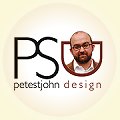 Museum exhibits, trade show booths, store displays -- in a way they are taken for granted. But the best ones attract our attention, draw us in, and connect us to what we're seeing. Your booth design may make the difference between attracting new clients at a trade and wasting opportunities. A store display can make a huge impact on sales. Pete St. John makes that difference for his clients, and is having a great time running his own design business.
Museum exhibits, trade show booths, store displays -- in a way they are taken for granted. But the best ones attract our attention, draw us in, and connect us to what we're seeing. Your booth design may make the difference between attracting new clients at a trade and wasting opportunities. A store display can make a huge impact on sales. Pete St. John makes that difference for his clients, and is having a great time running his own design business.Pete St. John Design is a home based Groton business that has clients all over the country. St. John has designed exhibits for The Museum of the Earth in Ithaca, The Mary Brogan Museum of Art and Science in Tallahassee, The New York State Military Museum, and the Rochester Museum and Science Center, displays for the Seward House, Mirrorshow Management, and in-store designs for Cartier and Cannon.
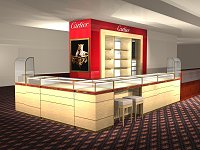 | 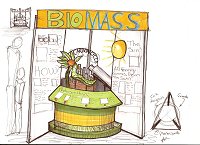 |
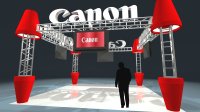 |
His wife Lisa works with him part-time. "She's a wonderfully talented graphic designer," he says. "She also does all our research and content writing. She loves it. She has a degree in English, and loves writing."
A native of Norwich, New York, St. John studied stage design at SUNY Freedonia. He worked in Buffalo building sets for a couple of years, and then worked at the Syracuse Stage. But without an MFA stage design jobs were scarce, and St. John wanted to design.
"That's really where my passion is," he says. "That's what I want to be doing."
He decided to go to RIT for industrial design. After finishing his classes in 2003 he began freelance designing trade show booths, and worked for worked for Mirrorshow Management and RES Exhibits.
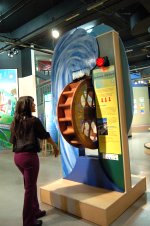 |  |
The Museum of the Earth brought him to Ithaca. The museum had just been built and he was hired as exhibits manager to take care of their collections. There he worked on their first in-house produced exhibits and set up exhibit shop.
"I loved it," he says. "I had worked with the Rochester Science Center while I was at RIT on an exhibit that shows the water cycle. You start as water in a big ball pit, then you go up and evaporate. You come across the bridge and you condense. You go down the slide as rain, and hit the landing and go down another slide as runoff, back into the water. That was it for me. Once I saw that I could use my creativity and the construction skills I had to build this stuff, I was hooked. I decided my job was to do museum work."
St. John met Lisa, who was finishing her last week at the Museum of the Earth, during his first week there. He stayed for a year before leaving to start his own design firm three years ago.
Today he splits his time between prospecting for clients and design work. He contracts out the actual building and says that 90% of his vendors are New York based. That gives him the freedom to concentrate on the design itself for museums, trade shows, and retail stores. He also works with architects, creating three dimensional views that helps clients visualize what their job will look like. This is particularly useful because clients often have a hard time interpreting floor plans and elevations.
"The three cornerstones that PSD is based on are creativity and experience (and the ability to make it), transparency, and flexibility to work with varying budgets," he says.
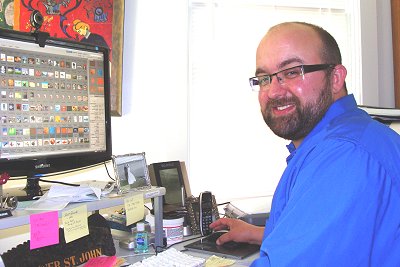
Pete St. John
He stresses transparency, which he characterizes as clients talking directly to the person who is designing their job. He says that is something the larger firms do not typically offer, and says it is important because it insures clients get what they think they are getting.
"We're a purposefully small design company," he says. "I could easily balloon up my staff, but I don't want to. A lot of our customers have dealt with larger firms in the past and the problem they have is you talk to a design director, and you don't ever talk to the designers. Now your job is being designed by someone you never spoke to. you have no idea what's going on and you were sold on the job by someone else entirely."
St. John says that eventually he'd like to build the company to a maximum of five designers, possibly hiring others who want to work from their own homes and telecommute to work for him.
While he enjoys trade show work, he is in love with museum exhibit design. When working for museums he makes sure he gets the full tour, front and back.
"This is probably one of the coolest perks for me," he says. "As an exhibit designer I get access to the museum and staff. Every job I take I get to go backstage and wander through the museum, typically with the executive director or the head of collections. I get to see the really cool stuff."
As the economy has become more difficult, St. John has spent the past six months pushing for local business. He has joined the Tompkins County Chamber of Commerce, and had a booth last month at Showcase Tompkins.
"It's a tough one right now," he says. "The way the economy has hit us, in the past ten firms would bid for jobs. Now there are 40 firms. We still offer that you get to talk directly to the designer. there is no miscommunication. There is a personal relationship that is built with our company. That's how we're still very competitive."
He says he loves the business side, meeting with potential clients and building relationships. Running a small business has its perils, but St. John exudes enthusiasm and confidence in what he has to offer.
"It's a a roller coaster, and I love roller coasters," he says. "It's terrifying and unbelievably rewarding at the same time. I love that I've found an outlet for my creativity. It connects people to something."
----
v5i28



